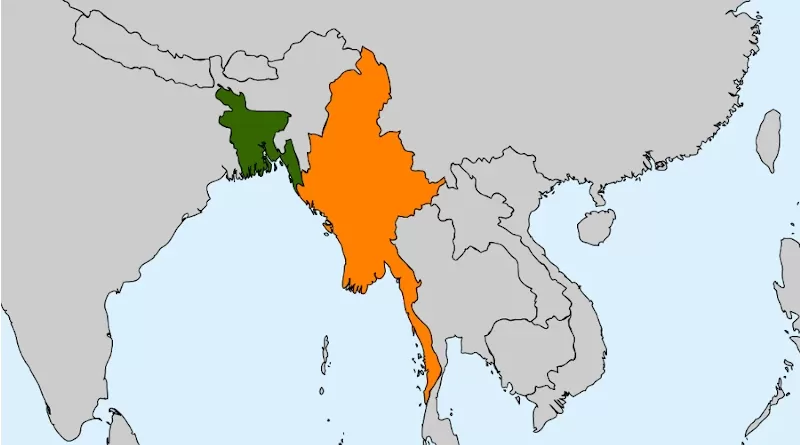50 Years Of Myanmar-Bangladesh Ties – OpEd
In the case of bilateral relations, there were two issues that caused some annoyance between them. The first was the demarcation of the sea-boundary between them. It is a matter of satisfaction that the matter was settled peacefully by the 1982 International Tribunal of the Sea Convention in March 2012. As Myanmar and Bangladesh, both share the Bay of Bengal area and 271km long border, Myanmar and Bangladesh both can take part in tackling nontraditional security threats in the Bay of Bengal such as tackling piracy, illegal drug dealing, human trafficking, environmental degradation, countering terrorists in the region.
The second is on the Rohingya refugee issue. Between August and November 2017, it was reported that a military operation in Myanmar had forced more than 700,000 Rohingya to cross the border into neighboring Bangladesh.
The Bangladesh government has faced the Rohingya crisis many times. In 1978, an anti-insurgency operation by the then military government of Myanmar in Rakhine State resulted in a massive brutal crackdown, with some 300,000 Rohingya crossing the border into Bangladesh. This is again in 1991-92, the second wave of more than 250,000 Rohingyas fled to Bangladesh to escape the ongoing military repression. The two countries have resolved the issue peacefully through bilateral talks. But current 2017 Rohingya crisis needs a fruitful sustainable solution between Myanmar and Bangladesh to bolster the ties. Definitely, Bangladesh and Myanmar should find a durable Closer Bangladesh-Myanmar ties have great economic potential – but the Rohingya issue must be resolved. Enhanced bilateral ties between Bangladesh and Myanmar could contribute to the growth of trade and investment relations with ASEAN and BIMSTEC countries.
There are other routes to bilateral cooperation. Myanmar is rich in natural resources such as tin, zinc, copper, tungsten, coal, marble, limestone, natural gas, hydropower, etc. Myanmar could thus be a major source of energy for Bangladesh to ensure its energy security.
Myanmar is also a major supplier of natural wood to the world. While it has traditionally eyed foreign investment in the oil and gas sector, the country has recently shifted its focus to attracting production-based investment. The country is well ahead in power generation following a good investment in hydropower generation. The tourism industry is also a promising sector of the country. Religious tourism can be a source of potential. There are many Buddhists Biharis in Bangladesh.
A number of important Buddhist archeological sites have already been uncovered in different parts of Bangladesh. Bangladesh is believed to be a rich repository of South Asian Buddhist heritage. In order to draw the world’s attention to the rich Buddhist heritage in Bangladesh, the Government organized an international event in collaboration with World Tourism Organization in October 2015.
There are a number of magnificent modern-era Buddhist temples in Bangladesh. The Golden Temple at a hilltop in the Bandarban district is probably the most charming Buddhist temple in Bangladesh. Gigantic Buddha status in Dhaka, Chittagong, and other parts of Bangladesh are special attractions for devotees and tourists. There are also a number of Buddhist learning centers and pilgrimage spots in Bangladesh.
This area of archaeological sites refers to Paharpur in Naogaon, Mahasthangarh in Bagura, Mainamati in Comilla, and Bikrampur in Dhaka district. Each of these sites has unique qualities as part of history. Some archaeological sites are important for both Hindu and Buddhist investigation because religious sculptures of each can be found. Thus, Myanmar and Bangladesh can exchange religious tourism.
Through the import of gas and electricity, Bangladesh can obtain its future energy security. The two countries can jointly explore oil and gas fields in the Bay of Bengal. Bangladesh can also contribute to the development of Myanmar’s infrastructure.
The proposed construction of the Asian Highway, funded by the Asian Development Bank, can increase land connectivity between the two countries and increase trade in products such as fertilizers, plastics, cement, furniture, etc. Bangladesh is on the way to the completion of its railway project Dohazari-Cox’s Bazar railway line. The line will run from Dohazari in Chattogram to Cox’s Bazar (one of the most popular tourist destinations in the country). This line can be extended to North East India, Nepal, and Bhutan. If this line can be extended to China-South East Asia via Bangladesh’s Ghundhum- Myanmar as part of the proposed Trans Asian Railway Network Asian Highway Network, the whole region can definitely benefit. Myanmar should take such an initiative to join the Trans Asian Railroad.
Myanmar, which at present does have sophisticated manufacturing, can import electronics and pharmaceutical products that are readily produced from Bangladesh and benefit from the technology transfer.
However, the two countries can also increase agricultural production through joint ventures. Apart from adopting joint investment projects, Bangladesh can increase imports of various agricultural products including pulses, spices, fish, and rice. Enhanced bilateral ties between Bangladesh and Myanmar could contribute to the growth of trade and investment relations with ASEAN and BIMSTEC countries. This will create an opening to solve the Rohingya problem and stop militant activities.
Basically, the Rakhine region of Myanmar can be used as a trade hub between Bangladesh and Myanmar. The agro-products in Rakhine need a viable market. Bangladesh can be a big market for the goods that are produced in Rakhine. On the other hand, Bangladesh has vast and tremendous experience in garments and production of agricultural sectors. Myanmar can exchange Bangladeshi expertise to benefit. Myanmar’s products (Known as Burmese products are very popular in Bangladesh), Myanmar and Bangladesh can set up some border hats (border market) between Bangladesh and Myanmar to boost up the trade. India and Bangladesh are benefitting from such kinds of border hats at the border. Thus, strengthening people-to-people contact, bolstering public diplomacy between the two sides can mend the strained ties between two neighbors.

